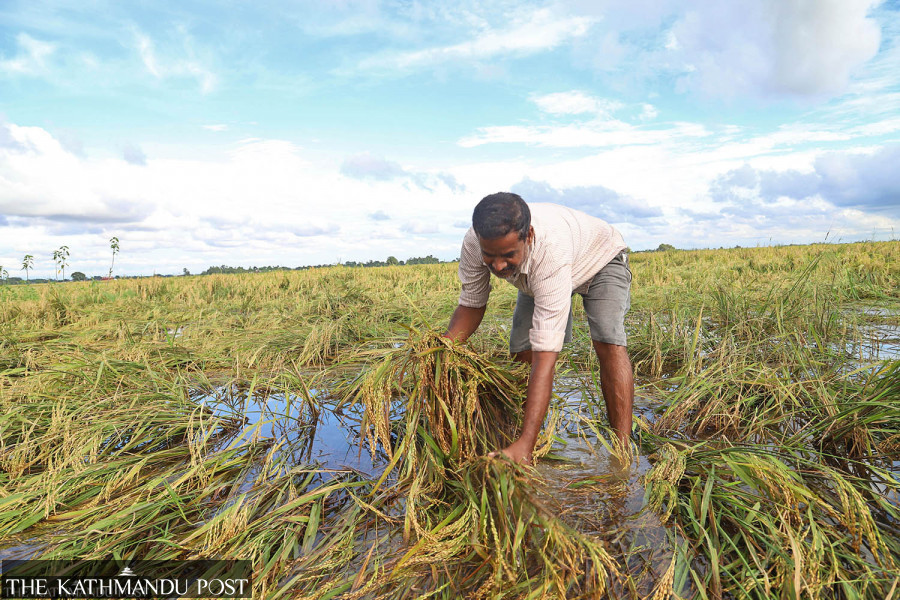Columns
Rethinking Nepal’s agriculture development
We must support producers by linking them with markets to transform agricultural value chains.
Padam Bhandari
Many development projects in Nepal focus on strengthening smallholder farmers’ input supply rather than linking them with markets and agro-processors. There is little evidence that development projects are succeeding. First, such projects are worked with startups and small and medium enterprises (SMEs) with a limited economic footprint. Second, successful private sector partners do not crowd in other entrepreneurs or businesses, thereby kickstarting a virtuous cycle. Third, development projects pursue an “actor-based” rather than a “rules-oriented” approach, consequently failing to remove the root causes of unsatisfactory market outcomes.
After this unsatisfactory result, some startups evolved into game changers by offering smallholder farmers and agribusinesses alternative sales channels, transportation service providers and access to distant markets. Others are improving post-harvest management practices. A few projects ran a marketing campaign promoting domestic consumption, helping local, provincial and federal governments better understand and assert their role in agriculture. Still, the policy work wasn’t reality-oriented, and the public-private partnership had weak commercial viability and private-sector engagement. Development projects also missed the opportunity to work with the government and vice versa on concrete, specific and targeted policy interventions that could, in the short term, have contributed to the commercialisation of agriculture.
Commercialisation and transformation
The development programmes aim to contribute to the commercialisation and successful transformation of agricultural markets in Nepal. They focus on provincial and local levels by providing incentives for investments and making it more attractive for agribusiness to source raw materials domestically and convert them into higher-value produce. The commercialisation of agriculture—in the context of Nepal—means that smallholder farmers move from subsistence farming to increasingly produce for the market, and agribusinesses start processing the agricultural produce into higher-value products. The development programme’s key outcomes and impact indicators should also be read in this vein.
As smallholder farmers increasingly produce for the commercial market and agribusinesses start processing more agricultural produce in ever greater volumes, this should translate into agribusinesses, particularly SMEs, escalating their trade value of agricultural produce and women and men, including from discriminated groups. Some development projects have sought to achieve their impact on gender equality and social inclusion through their choice of sectors (those with a high participation of women and marginalised groups). However, many have yet to identify and address discriminatory practices and opportunities for empowerment.
On the one hand, the term transformation appears to have been used loosely and synonymous with the commercialisation of agriculture. On the other, market development seeks to induce “systemic change”. As scholars describe, transformation is generally seen as representing a more profound change, one in which key actors gain a new perspective and rationale for action, consequently adopting new attitudes and behaviours, which—through their actions—ultimately lead to fundamentally different system functioning and outcomes. Thus, transformation is disruptive and refers to a fundamental, irreversible and visible change in societal systems. So, for the development programmes, the emergence of a rich agro-processing industry would be a tell-tale sign of a systemic change.
Supporting farmers
The development programmes should identify and address key market development constraints through policy interventions and public-private partnerships for marketplace development. The focus should be on local governments, involving the provincial government to enhance support services to agribusinesses, including both agricultural (e.g., warehousing, post-harvest management services, custom hiring services etc.) and non-agricultural (e.g., access to finance, business administration services, marketing support etc.). It is also important to support service providers and agribusinesses in product innovation, such as developing new products, or diversifying existing ones, or improving large cardamom dryers etc.
The development projects should complete their current commitments, support promising startups, help set up a medium-term marketing campaign for domestic consumption and remove one specific policy obstacle to commercialising agriculture. Later, it can serve as a trial for donors and inform them whether continued policy engagement in agriculture has a future. The donors should review their support to invest more time and effort in ensuring a common understanding of objectives, approaches and terminology with the government and their implementing partners. They should then move to the value chain, seeking to enable agribusinesses to process more domestically sourced agricultural produce into higher-value food and animal feed products. With Nepal’s federal structure, the donors should now have a geographic focus.
Earlier, the development programmes focused on strengthening input supply to smallholder farmers (e.g., seeds, fertilisers, and extension services) and forward market linkages between smallholders and agro-processors. The evidence showed that whilst micro-level results were achieved, the programmes were unlikely to attain systemic impact. Therefore, the donors should move to the value chain, seeking to enable agribusinesses to process more domestically sourced agriculture
produce into higher-value food and animal feed products.
The funded development programmes should support governments, service providers and agribusiness through technical assistance, either by offering advisory support from the team or through the funding of external technical expertise, limited co-investments in, for example, equipment, packaging, or marketing material, and its network, linking partners to other (previous) partners and/or government contacts. The implementation team should have policy, agricultural and non-agricultural services expertise. Such programmes should focus on market system development, consisting of a systematic approach to improving markets for society’s poor, discriminated and disadvantaged.
At the core of market system development lies “analysis”, which should identify the underlying causes rather than the symptoms of weak market performance. By identifying and addressing the root causes, one can unlock market systems and realise large-scale system change. We should strengthen farmers’ product innovation by offering them better service access. In addition, we must work with the three tiers of government on policy development and public-private partnerships in market infrastructure to contribute to the commercialisation and transformation of agricultural value chains, thereby creating an industry that generates employment and offers increased sales and income to farmers.




 8.12°C Kathmandu
8.12°C Kathmandu













%20(1).jpg&w=300&height=200)

